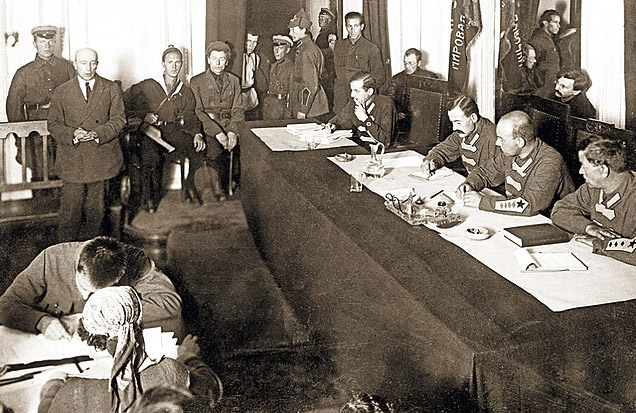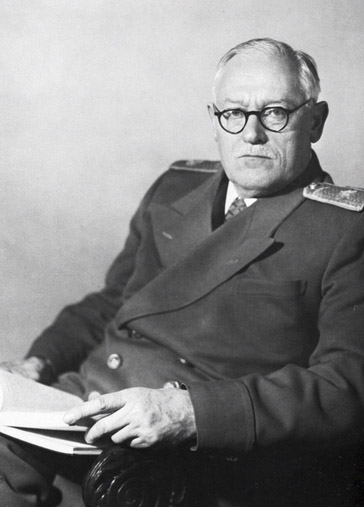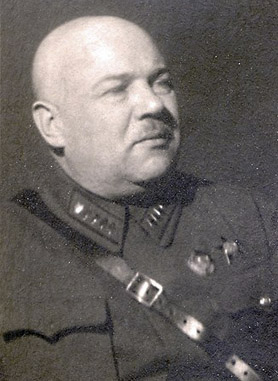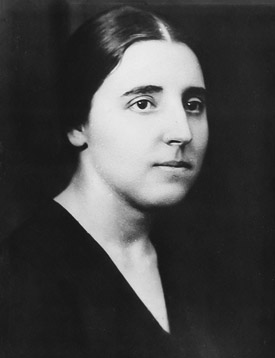
- Articles
Conversations on Lenin, Stalin, and Bolshevik Women: Part II—Evil Begets Death by Adam R. Bogart, PhD and Miguel A. Faria, MD
The purges of the Red Terror in the 1930s ended with Beria who replaced Nikolai Yezhov (or Ezhov) and ended the Yezhovshchina. Stalin probably realized that war was coming and, as pointed out by his friend Kliment Voroshilov, he had already decimated the members of the Politburo and the officers of the Red Army. It was only the Red Terror of 1937-38, the purges of communists and Bolsheviks (there were none left, anyway) that stopped, the massacres of enemies of the people (ethnic nationalities as well as common Russian people) continued. The repression of the “enemies of the people, wreckers, and spies” did not stop until Operation Barbarossa and World War II. During “The Great Patriotic War,” the repression, though, was turned against the soldiers themselves, especially those who had been in enemy territory or POWS, to be persecuted by the NKVD. Towards the end, Stalin had the Jews in the crosshairs, but fortunately he died before he could carry it out. — Dr. Miguel A. Faria

Other Perspectives on the Pandemonium
You are correct in your assessment of the Yezhovshchina. I do need to point out that while the mockery of justice occurring between 1936-1938 was conducted via public show trial for several undesirable classes Stalin wanted eliminated, it did not spare the ordinary citizen either, who was just as likely to be caught up in the Red Terror of that era. But for such people, he did not need the sleaze passing for evidence conjured up by Andrey Vyshinsky (1883-1954) and Vasiliy Ulrikh (1889-1951). Mere arrest was proof of guilt, and while a signed confession was desirable, it did not prevent the NKVD from passing and carrying out sentence without any trial whatsoever if one could not be obtained.
As I had pointed out in my previous comment, studies have shown that while foreign communists were initially convinced of the guilt of the defendants, Russian citizens were much more likely to believe the trials were a ruse. Stalin was probably aware of this, and so although Russians kept quiet about it (except for the odd circumstance, such as one unknown citizen Volkogonov quotes as saying, “In Nicholas’s time they couldn’t hang enough people, now they can’t shoot enough.”) he still needed a scapegoat to place blame for the purges on in order to maintain his cult of personality. Yes, Beria may have been the one to publicly put a stop to the purges and make sure that the public also knew Yezhov was the one who was out of control, but as much power as Beria had, he could not have done this without the approval of Stalin. The powers granted Beria were formidable, but not completely plenipotentiary.

I don’t have a copy of Volkogonov’s book on Stalin with me at present, but I believe it was he who first suggested that part of the reason the purges were stopped was because Stalin felt even he was losing control over them. Yes, Stalin did sense that war might be coming with Germany, and Voroshilov did give him repeated warnings (as it would appear he was the only one who could do so and not suffer severe ramifications) but I’m not sure that even Stalin originally anticipated that the purges would gobble up two of his NKVD heads who were in charge of them. That they did so with his approval is beside the point. It is this “duality of thinking” (also contradictory, which we have been previously discussing as characteristic of the Bolshevik mind) that seems to be what Stalin was employing. Just look at how long after he ended the purges it took Voroshilov to finally convince him that he’d better do something about the Germans, as they had invaded the USSR and already killed millions. Yet, wasn’t fear of that why he ended them? That is why, by the way, I mentioned the alternative theory of why Hitler invaded Poland—because he saw evidence Stalin was about to invade it first. That one demonstrated that it didn’t happen that way does not mean this theory couldn’t be true. I think almost everybody would agree with you, as it has always been well known that Hitler invaded first. All that is being suggested is that there has to be more to the story, because it is so hard to believe that Stalin would be so trusting of the Germans so late in time when, as you correctly point out, he realized war might be on the horizons as early as 1938.
On that note of speculation, I would like to end this segment with a few links. The first is to a portion of the “Trial of the Twenty-One” in early March of 1938. Here, Judge Ulrich convicted Rykov, Bukharin, and Yagoda. It is instructive to pay attention to what Ulrich finds them guilty of, and what sentence he passes for all of them. Also of note is what Prosecutor Vyshinsky finds suitable to present to the court as evidence. There is no rebuttal to this “evidence,” because not only do the defendants have no right to counsel; they have no right to be present at their own trials.
There were three videos that I believe showed the earliest documentary on Stalin produced just before the USSR crumbled. They aired on PBS in 1990, and despite how much we have learned since then, I rarely have come across a more enjoyable, well done, and informative short historical series. Unfortunately, the links are no longer available. All of the historic personalities featured were colorful characters. One such character who gives (unknowingly, I think) great insight into how she really felt about her father Stalin, was Svetlana Alliluyeva, who she denounced for crimes in no uncertain terms, and makes this very clear, but it is striking how she gives one the feeling that she would rather not have to say anything about him, and if only people would leave the whole terrible subject be…
I know there was a great rift between them, but it almost seems to me that she still loves him. I would not be surprised if she lacked a considerable amount of self-insight, but it is well known how much he adored her, and being adored by Stalin was not something very common. So, Svetlana holding a life-long ambivalent attitude towards her father and not completely appreciating it would not be that shocking. — Dr. Adam R. Bogart
The Bolsheviks followed the lead of their sanguinary and relentless leaders. Let’s not forget that the Cheka, under Felix Dzerzhinsky (“Iron Felix”) and Lenin, not Stalin, set up Operation Trust, to eliminate White Russians who had already made it to exile. They abducted and killed General Miller, and countless other White Russian emigres. They lured legendary figures like former revolutionary Boris Savinkov and British agent Sidney Reilly into the Soviet Union, where they were arrested, tortured, and killed! (See Christopher Andrew and Vasili Mitrokhin, The Mitrokhin Archive: The KGB in Europe and the West, 2000)
General Kutepov was kidnapped and supposedly died of a heart attack during the kidnapping in Paris in 1930; Lieutenant General Pyotr Wrangel, former commander Caucasus Army South was poisoned in Belgium by a servant a Soviet agent, et cetera. Pavel Sudoplatov’s Special Tasks: The Memoirs of an Unwanted Witness, a Soviet Spymaster (1994) is an excellent source.
Andrey Vyshinsky, as you know was a Menshevik that Stalin spared, knowing he could be useful and indeed he was, tremendously so. Vyshinsky survived Stalin by one year, and eventually went on to serve as Foreign Minister (1949-1954). He and Alexandra Kollontai served as ministers at the same time, she as cultural ambassador to various countries. — Dr. Miguel A. Faria
Yes, and not only that, but Prosecutor Andrey Vyshinksy had been one of those who signed an arrest warrant for Lenin in 1917, when Kerensky was still in power. To think of how many thousands were purged for so much less, and with Vyshinksy making the case against them!
As for Kollontai being cultural ambassador, I think that was one way Stalin enjoyed screwing (no pun intended) with her. He believed that sort of position amounted to practically nothing, and she knew it. — Dr. Adam R. Bogart
True, Power Begets More Sex, But…
There is no doubt of what you have said about sex and power. Personally, if a woman has anything she can use (brain or body or both) to get closer to a power source, I think that is fair because those “power sources” used whatever talents (good and evil) they were granted to gain their power.
But this is not only about Bolshevik women and sex but also on whether Bolsheviks were able to avoid that method of power climbing, as that is how they portrayed themselves in early Soviet Russia. My conclusion is that it seems like a lot of them more or less did, because as you point out, neither Lenin nor Stalin would be considered womanizers by even the standards of their day.
There were many who would be considered womanizers in that era of Soviet history, but not the highest leadership. One good example is an alleged quote from Stalin: “What shall we do? We shall envy!” Что делать будем? Завидовать будем! Rumored to have been said after receiving a report about Marshal Konstantin Rokossovsky’s inappropriately large number of female lovers.
He didn’t care what the NKVD said Rokossovsky was doing, but yet he probably did not indulge in nearly as many encounters as did Rokossovsky. He jokes about it; he is not jealous or offended. Rokossovsky was not even a Russian, but a Pole. Not all Russian Bolsheviks appreciated this. Stalin wasn’t Russian either, but over the course of his time in the leadership, he seems to have developed distinct feelings of Russian nationalism, nonetheless.
I would like to point out that in the film Stalin (1992), Stalin is awoken with a woman in his bed on 9 Nov 1932 to come see his wife’s body with a bullet in her head. This is not the only casual portrayal of Stalin satisfying sexual desires as they arose in that movie. Funny enough, another might be when 17-year-old Nadezhda Alliluyeva reveals to him on a train that she has memorized some of his poetry he wrote in exile. It was fairly good Georgian poetry.
I myself have pointed out numerous minor historical inaccuracies in this movie, so I am not saying that is really what happened, but I am saying those who wrote the script somehow developed a similar notion of Stalin’s sexuality as I did. — Dr. Adam R. Bogart

Forensic Musings on the Suicide of Nadezhda Alliluyeva
It is often said that Stalin’s second wife, Nadezhda Sergeyevna Alliluyeva (1901-1932), had a tremendous argument with him in November 1932 because he and his cronies were celebrating the 15th anniversary of the October 1917 revolution too lavishly for communists, while she saw how poorly the general population was living.
This is why Stalin did not want his wife to get a college education. He knew she would see how badly the people were being treated, and how well the party elite lived. She was found with a bullet in her head the next morning. I believe Stalin loved her in his own way, but he certainly was capable of murdering his own wife because she embarrassed him in public.
But the other camp in this matter believes she committed suicide. She was a devoted communist and unlike Stalin, really cared about the common Soviet people. Her economic ideas may have been a bit kooky, but unlike him, she possessed the faculty of being human. It is easy to see her killing herself when she saw what the communist system really was like. It shattered all of her ideals.
From all I can tell, she was buried without an autopsy, as the cause of death seemed clear—a gunshot to the brain. I’ve no doubt that was the cause of death. What I wonder is why her body is not exhumed? It is probably little more than a skeleton now, but I am betting the wound in the skull bones would tell us where the shot was fired from and how close it was fired from. Also, the angle, and whether it is consistent with suicide.
In the U.S., this is such a common problem dealt with by the police and medical examiners all the time. MSCT can reconstruct a bullet trajectory with great accuracy, even if the soft tissues have long disappeared. It is not a big deal, radiologically speaking. Yet, this is still a fascinating question for many historians.
Why not solve it once and for all? Get the body! Or could it be the Russians don’t think like us? They don’t care or they do not like disturbing corpses. Who would stand to benefit or lose by whatever was found in that coffin? Contemporaries have long since died.
Further research has uncovered a solitary claim that she was autopsied, and the pathologist in 1932 found the bullet to have been fired from a distance of 4 meters, indicating that Stalin likely did kill her. The doctor was executed following a show trial shortly after his report. I am not sure I believe this, as why would Stalin allow any autopsy, if he knew they would find that? But still, exhumation would show the autopsy cuts in the skull if this were the case. This scene is reconstructed in the 1992 movie Stalin with Julia Ormond as Nadezhda.
The historical faithfulness is commendable, but even here the movie lets the viewer draw their own conclusion as to how she was shot. — Dr. Adam R. Bogart
Very true Adam. But I believe the Russians want to leave their communist sordid past behind and don’t want to uncover the buried wrecks of communism. They don’t want it “thrown back in their face.” This is nicely stated by the young, urbane, SVR chief in the masterpiece film Archangel (2008) with Daniel Craig, whose review is also noted under the same link above on Hacienda’s Random Notes: Classic Movies and Documentaries.
Incidentally, Adam, Nadezhda committed suicide at Stalin’s home at the time, that is, the exuberant Poteshnye Palace (“Palace of Amusement”) built by Peter the Great’s father, Tsar Alexei (1645-1676), the second Romanov Tsar. The best narrative on the incident is found in Simon Sebag Montefiore’s tour de force, Stalin: The Court of the Red Tsar (2003). — Dr. Miguel A. Faria
Nadezhda’s Skull and Soviet Executions
You seem to agree a physical examination of the skull and CT scans of it will tell us what we need to know about the distance and angle of the shot (and obviously, that we hardly need the brain), but what is your opinion? Do you personally believe she committed suicide or that he might have killed her? I was never sure, even now. There are, of course, many Russians who do wonder about it (you can see this if you read some Russian accounts of the incident), but I suppose you mean the overriding desires of the population to rid themselves of their horrid past.
There is also the issue that you have referred to in the past—the explanation of why non-physicians (or even non-scientists) cannot be medical historians. This is why it is hard to determine many of the medical aspects of the sick Soviet leaders we have been discussing, because the popular literature is either obviously wrong or at least inconsistent.
I believe it was in Sebag Montefiore’s book (but I could be wrong) that I first read of Yezhov appropriating Yagoda’s property for himself while Yagoda was being prepared for show trial. Two gruesome items he found were the bullets extracted from Kamenev’s and Zinoviev’s brains after their executions. I don’t doubt a man like Yagoda would want these as keepsakes, but since I read that, I have read numerous accounts of the same story, and all claim the bullets were removed from the brains.
I find this hard to believe, as most of the Soviet executions following “conviction” were carried out by gunshot at point black range to the back of the head. Now, I have seen photographs of various skulls exhumed after Soviet murder in this fashion (such as those found by the Germans in Katyn) and all show frontal or temporal exit wounds with no bullet left inside the head. Nazi pathologists noted this. Of course, Hitler was not attempting to obtain justice for the Poles, but rather pin (and rightfully so—maybe the one thing Hitler ever did do right) the crimes on Stalin. By the 1930s, pistols were powerful enough that they caused perforating wounds at point blank range as opposed to penetrating ones.
In contrast, Abraham Lincoln’s autopsy report after a point-blank shot to the back of his head shows the bullet only had enough kinetic energy to land in the anterior frontal white matter and fracture the orbital plates (yes, I know these plates may be fractured by a bullet to the brain from anywhere, but not in his case—it was almost direct). The longitudinal sinus was opened, but that is only because the bullet entered near that area. My point is that the Derringer ball in those days did not have the kinetic energy to exit.
So, I wonder if these bullets Yezhov took really needed to be removed from the brains, or Yagoda just picked them up off the floor? It is more sensational to say they were still in the brains, but is it scientifically accurate? A journalist or pure historian would never question that. — Dr. Adam R. Bogart
As for Nadezhda, it is almost certain that she committed suicide. She was a devoted communist, a true believer, with blind faith in the falsities of communism and the utopia of the Workers’ Paradise. Yet, she had seen the lies under Stalinism, the mass starvation, the purges, and the elimination of friends as “enemies of the people,” et cetera. It was more than she could bear and besides, she had a history of instability and depression. Stalin made her life miserable on purpose and on top of everything else drove her to suicide!
I don’t think you read about this gruesome bullet details in Montefiore’s books, but details are sprinkled throughout several narratives as braggadocio and mementos of their evil deeds. Nevertheless, as to specifics, without radiographic evidence or examination of the skulls, we cannot ascertain whether the bullets were picked up from the floor or from inside the skulls. The assassins may have used different types of pistols, British, German, or Russian of different calibers.
All the NKVD chiefs—Yagoda, Yezhov, and Beria—ultimately paid with their own lives.
My reviews of Beria and Yezhov’s biographies may be instructive in some of these details. Our information on the Katyn Forest massacre of the Polish officers by the NKVD is graphic but a relevant article on NKVD methods and ballistics, which I recommend to our readers — Dr. Miguel A. Faria
Read Part I of this article
Read a conversation about Lenin’s and Stalin’s illnesses
Written by Dr. Adam Bogart and Dr. Miguel A. Faria
Adam Bogart, PhD, is a Behavioral Neuroscientist at the Sanders Brown Center for Aging University of Kentucky, Lexington, KY. Behavioral Neuroscience Kent State University Kent, OH. Post-doctoral fellow at the Albert Einstein College of Medicine, Gruss Magnetic Resonance Research Center Bronx, NY. MS Immunology conjointly Adelphi University/Mount Sinai Medical Center New York City, NY.
Miguel A. Faria, M.D., is Associate Editor in Chief in neuropsychiatry; history of medicine; and socioeconomics, politics, and world affairs of Surgical Neurology International (SNI). Clinical Professor of Surgery (Neurosurgery, ret.) and Adjunct Professor of Medical History (ret.) Mercer University School of Medicine. He is the author of several books including Cuba in Revolution: Escape From a Lost Paradise (2002), and America, Guns, and Freedom: A Journey Into Politics and the Public Health & Gun Control Movements (2019). His most recent book is Controversies in Medicine and Neuroscience: Through the Prism of History, Neurobiology, and Bioethics (2023), published by Cambridge Scholars Publishing in Newcastle upon Tyne, England.
This article may be cited as: Bogart AR, Faria MA. Conversations on Lenin, Stalin, and Bolshevik Women: Part II—Evil Begets Death. HaciendaPublishing.com, April 2, 2023. Available at: https://haciendapublishing.com/conversations-on-lenin-stalin-and-bolshevik-women-part-ii-evil-begets-death-by-adam-r-bogart-phd-and-miguel-a-faria-md/
Copyright ©2023 HaciendaPublishing.com